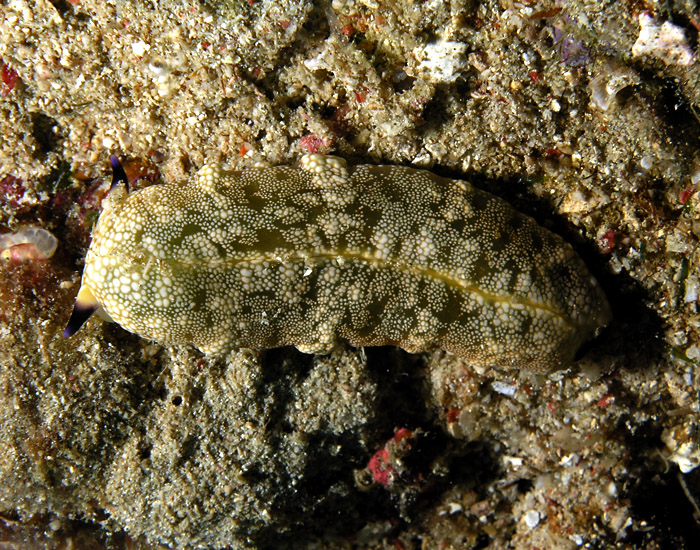Plakobranchus Ocellatus on:
[Wikipedia]
[Google]
[Amazon]
''Plakobranchus ocellatus'' is a
''Plakobranchus ocellatus'' van Hasselt, 1824.
Accessed through: World Register of Marine Species on 2014-11-08 It is found in shallow water in the Indo-Pacific region.
 The body is broad, truncate, and rather flattened, up to long. The head is flat and squarish, the
The body is broad, truncate, and rather flattened, up to long. The head is flat and squarish, the
species
In biology, a species is the basic unit of classification and a taxonomic rank of an organism, as well as a unit of biodiversity. A species is often defined as the largest group of organisms in which any two individuals of the appropriate s ...
of sea slug
Sea slug is a common name for some marine invertebrates with varying levels of resemblance to terrestrial slugs. Most creatures known as sea slugs are gastropods, i.e. they are sea snails (marine gastropod mollusks) that over evolutionary time ...
, a sacoglossa
Sacoglossa, commonly known as the sacoglossans or the "solar-powered sea slugs", are a superorder of small sea slugs and sea snails, marine gastropod mollusks that belong to the clade Heterobranchia. Sacoglossans live by ingesting the cellular co ...
n, a marine opisthobranch gastropod mollusk
Mollusca is the second-largest phylum of invertebrate animals after the Arthropoda, the members of which are known as molluscs or mollusks (). Around 85,000 extant species of molluscs are recognized. The number of fossil species is e ...
in the family
Family (from la, familia) is a group of people related either by consanguinity (by recognized birth) or affinity (by marriage or other relationship). The purpose of the family is to maintain the well-being of its members and of society. Idea ...
Plakobranchidae
Plakobranchidae is a family of sea slugs, marine opisthobranch gastropod mollusks in the superfamily Plakobranchoidea. They superficially resemble nudibranchs but they are sacoglossans, members of the clade Sacoglossa within the Opisthobranchia ...
.Gofas, S. (2014)''Plakobranchus ocellatus'' van Hasselt, 1824.
Accessed through: World Register of Marine Species on 2014-11-08 It is found in shallow water in the Indo-Pacific region.
Distribution
This species occurs in the Indo-Pacific. Recent work on the photosynthetic abilities of ''Plakobranchus'' reveals that ''P. ocellatus'' is actually a species complex consisting of at least four distinct clades.Christa G., Wescott L., Schäberle T.F., König G.M., Wägele H., (2013) ''What remains after 2 months of starvation? Analysis of sequestered algae in a photosynthetic slug, ''Plakobranchus ocellatus'' (Sacoglossa, Opisthobranchia), by barcoding.'' Planta. Feb;237(2):559-72. doi: 10.1007/s00425-012-1788-6. Epub 2012 Oct 30.Description
 The body is broad, truncate, and rather flattened, up to long. The head is flat and squarish, the
The body is broad, truncate, and rather flattened, up to long. The head is flat and squarish, the rhinophore
A rhinophore is one of a pair of chemosensory club-shaped, rod-shaped or ear-like structures which are the most prominent part of the external head anatomy in sea slugs, marine gastropod opisthobranch mollusks such as the nudibranchs, sea ha ...
s being folded longitudinally. The mouth is at the front apex of the head and the eyes are very close together, being visible through the semi-transparent skin of the head. The dorsal surface of the sea slug has a number of longitudinal ridges, but when at rest, the parapodia
In invertebrates, the term parapodium ( Gr. ''para'', beyond or beside + ''podia'', feet; plural: parapodia) refers to lateral outgrowths or protrusions from the body. Parapodia are predominantly found in annelids, where they are paired, unjointed ...
are folded up over the midline of the body so that the dorsal surface is concealed from view. On the underside, the foot is broad and long, but is not clearly demarcated from the mantle.
The ground colour of this sea slug is usually pale green, beige, or cream with large ocelli (spots similar to eyespots) of cream, brown, pink, and purple in varying shades. The sole of the foot also has ocelli.
Habitat
These seaslugs live in sheltered, shallow water habitats with stones or gravel and silt. They feed on a broad food spectrum, including members of the genera '' Halimeda'', ''Caulerpa
''Caulerpa'' is a genus of seaweeds in the family Caulerpaceae (among the green algae). They are unusual because they consist of only one cell with many nuclei, making them among the biggest single cells in the world. A species in the Mediterran ...
'', '' Udotea'', '' Acetabularia'' and further unidentified algae, with an emphasis on '' Halimeda macroloba''.
References
This article incorporates CC-BY-3.0 text from the reference. * Jensen K.R. (2007) ''Biogeography of the Sacoglossa (Mollusca, Opisthobranchia).'' Bonner Zoologische Beiträge 55:255–281External links
* Hirose E. (2005). "Digestive System of the Sacoglossan ''Plakobranchus ocellatus'' (Gastropoda: Opisthobranchia): Light- and Electron-Microscopic Observations with Remarks on Chloroplast Retention". ''Zoolog Sci.'' 22(8): 905–916. * Trench M. E, Trench R. K. & Muscatine L. (1970). "Utilization of photosynthetic products of symbiotic chloroplasts in mucus synthesis by ''Placobranchus ianthobapsus'' (Gould), Opisthobranchia, Sacoglossa". '' Comp Biochem Physiol.'' 37(1): 113–117. * {{Taxonbar, from=Q3391089 Plakobranchidae Gastropods described in 1824